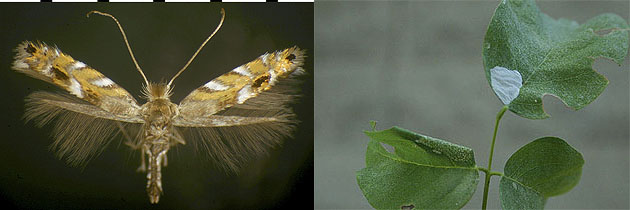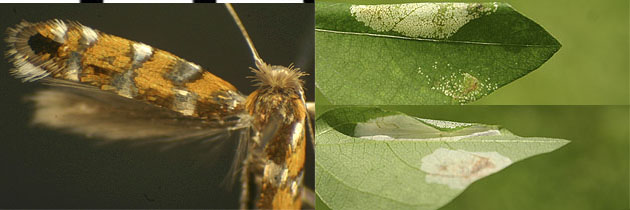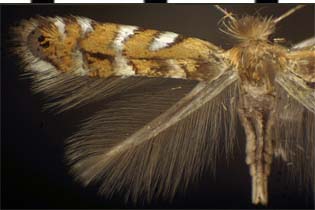
The genus Macrosaccus was erected by Davis and De Prins (2011). Two of the species, M. neomexicanus and M. gliricidius (which were described as new by Davis and De Prins 2011) are western. The remaining three species, which previously were assigned to Phyllonorycter, all occur in the eastern USA, including Illinois. Adults of the three species are similar in external appearance. Characters for differentiating them on sight are given below, but to assure maximally accurate identifications of adults of this species group, reared series of each of the three species should be obtained and compared for reference.
Each of the three eastern-USA species makes a white tentiform mine on either the upper or lower surface of the leaflet of a particular species of legume (Fabaceae). Macrosaccus robiniella (Fig. 1), as its name implies, feeds on black locust, Robinia pseudoacacia; M. morrisella (Fig. 2) feeds on hog peanut, Amphicarpa bracteata; and M. uhlerella (Fig. 3) feeds on our two Amorpha species, false wild indigo, A. fruticosa, and leadplant, A. canescens. The leaf mine of M. uhlerella is more compact than in the other two species and occurs more consistently on the underside of the host leaflet.
Braun (1908) gave characters for sight-identifying adults of these three moth species. In M. robiniella, the coloration of the basal part of the forewing is solid gray; in M. uhlerella, there is a small but distinct white patch on the posterior margin of the forewing at the outer limit of the basal gray area; and in M. morrisella, there is a white patch as just described for M. uhlerella, and also a narrow white line that runs medially from the base of the forewing almost to the anterior edge of the white patch, thus creating a white marking that nearly encloses the basal gray area of the wing. Also, as noted by Braun, the overall appearance of the vestiture is noticeably more shiny in M. morrisella than in the other two species (this difference is more pronounced in living moths than in spread specimens).

Figure 1. Macrosaccus robiniella. Adult, and leaf mines on black locust, Robinia pseudoacacia (Fabaceae). In the example illustrated here, an upperside and an underside mine can be seen on different respective leaflets of the same leaf, with the underside mine (lower left-hand leaflet) being in an advanced stage of development, whereas the upperside mine (top leaflet) is in a fairly early developmental stage. In the case of the latter, the markedly white color easily differentiates it from upperside blotch mines made on Robinia by two other gracillariid species, Parectopa robiniella and Chrysaster ostensackenella, the mines of which are yellowish in color.

Figure 2. Macrosaccus morrisella. Adult, and upperside and underside views of two leaf mines (one mature, one incipient or abortive) on a leaflet of hog peanut, Amphicarpa bracteata (Fabaceae).

Figure 3. Macrosaccus uhlerella. Adult, reared from leaf mine on false wild indigo, Amorpha fruticosa (Fabaceae).